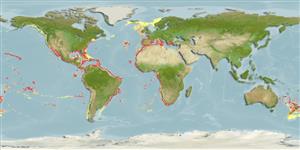Environment: milieu / climate zone / depth range / distribution range
Ecología
marino bentopelágico; rango de profundidad 200 - 1000 m (Ref. 58302). Deep-water
Eastern Atlantic: Madeira Island and Gulf of Guinea including western Mediterranean (Ligurian Sea, Messina). Western Atlantic: off Florida, USA. Eastern Pacific: Hawaii.
Tamaño / Peso / Age
Maturity: Lm ? range ? - ? cm
Max length : 30.0 cm TL macho / no sexado; (Ref. 5235)
Short description
Morfología | Morfometría
Vértebra: 193 - 204. Pale body color. No pectoral fin.
Found on the upper continental slope (Ref. 5235), over soft substrate (Ref. 58302).
Life cycle and mating behavior
Madurez | Reproducción | Puesta | Huevos | Fecundidad | Larva
Smith, D.G. and P.H.J. Castle, 1990. Synaphobranchidae. p. 195-198. In J.C. Quero, J.C. Hureau, C. Karrer, A. Post and L. Saldanha (eds.) Check-list of the fishes of the eastern tropical Atlantic (CLOFETA). JNICT, Lisbon; SEI, Paris; and UNESCO, Paris. Vol. 1. (Ref. 5235)
IUCN Red List Status (Ref. 130435)
Threat to humans
Harmless
Human uses
Más información
Nombres comunesSinónimosMetabolismoDespredadoresEcotoxicologíaReproducciónMadurezPuestaAgregación para la puestaFecundidadHuevosEgg development
Age/SizeCrecimientoLength-weightLength-lengthLength-frequenciesMorfometríaMorfologíaLarvaDinámica larvariaReclutamientoAbundanciaBRUVS
ReferenciasAcuiculturaPerfil de acuiculturaRazasGenéticaElectrophoresesheritabilidadEnfermedadesProcesamientoNutrientsMass conversion
ColaboradoresImágenesStamps, Coins Misc.SonidosCiguateraVelocidadTipo de nataciónSuperficie branquialOtolitosCerebrosVisión
Herramientas
Special reports
Download XML
Fuentes de Internet
Estimates based on models
Preferred temperature (Ref.
123201): 7.7 - 15.3, mean 11.5 °C (based on 271 cells).
Phylogenetic diversity index (Ref.
82804): PD
50 = 0.5001 [Uniqueness, from 0.5 = low to 2.0 = high].
Bayesian length-weight: a=0.00102 (0.00046 - 0.00225), b=3.06 (2.88 - 3.24), in cm total length, based on all LWR estimates for this body shape (Ref.
93245).
Nivel trófico (Ref.
69278): 3.8 ±0.3 se; based on size and trophs of closest relatives
Resiliencia (Ref.
120179): Medio, población duplicada en un tiempo mínimo de 1.4-4.4 años (Assuming tmax>3).
Fishing Vulnerability (Ref.
59153): Low vulnerability (20 of 100).
Nutrients (Ref.
124155): Calcium = 6.29 [1.78, 20.89] mg/100g; Iron = 0.269 [0.092, 0.742] mg/100g; Protein = 17.1 [14.9, 19.6] %; Omega3 = 0.3 [0.1, 0.8] g/100g; Selenium = 21.4 [6.2, 73.1] μg/100g; VitaminA = 8.37 [1.52, 41.15] μg/100g; Zinc = 0.291 [0.140, 0.580] mg/100g (wet weight);
